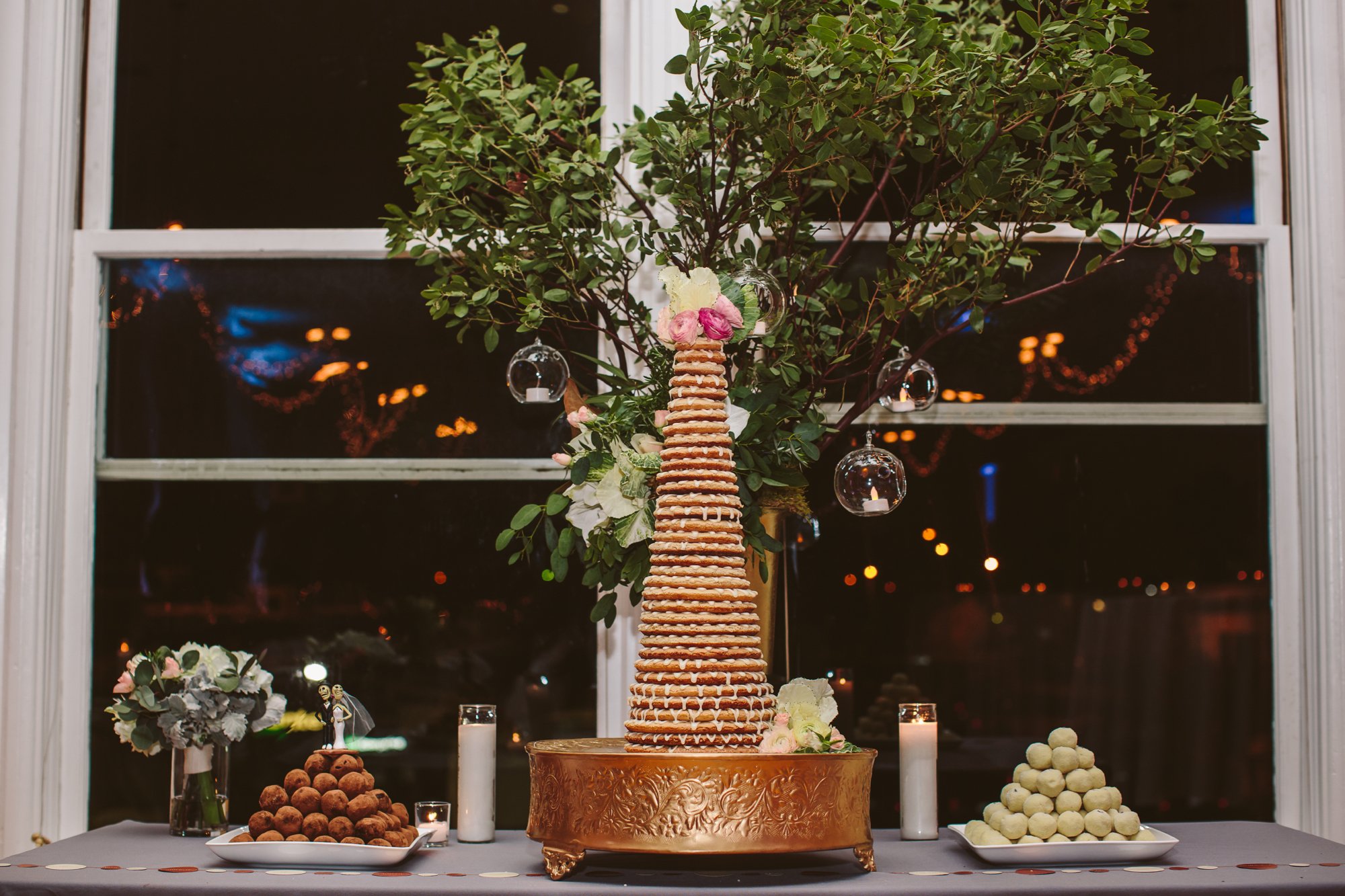Kransekage: Danish almond (wedding) ring cake
Cardamom-flavored chewy rings traditional at weddings and New Year's Eve parties.
Beautifully stacked kransekage tower.

Like many Americans, I can trace my ancestry back to many, many different countries. However, whether because my last name is Rasmussen, a classic Danish last name, (and my great-grandfather was Rasmus Rasmussen) or because I just love the culture so much, I feel the biggest connection to my Scandinavian-Danish heritage. So when I was betrothed and started diving into the (very wide) world of weddings, I immediately began looking up Scandinavian and Danish wedding traditions. There were a few traditions that jumped out at me, including one that involves cutting the groom's tie to symbolize his imminent wife's good sewing skills, which we decided to forego, but just one that stuck. Naturally, the one that stuck was the traditional wedding cake, called Kransekage.
More cookie than cake, kransekage is typically served at weddings and New Year's Eve parties and our wedding just happened to be on December 31st. The cake rings symbolize wedding rings and I suppose for NYE they are symbolic of the year going 'round and 'round, but I'm just hypothesizing. Apart from the serendipity, I was also drawn to kransekage because it's flavored with cardamom, probably my favorite dessert flavoring, and made with almond meal, egg white, and sugar, which is a recipe for success in my book. Lemon zest is the final ingredient that provides a welcome brightness. That's right, just a total of five ingredients and if you're into the world of gluten free (I eat everything, but just sayin'), then this dessert is for you. On a romantic note, serving this cake at our wedding made sense because my now husband visited me in Denmark (I was on a research stint there for a summer) way back when we first started dating. I've told him numerous times that if he hadn't visited it probably wouldn't have worked out because, I mean, come on - live a little! Luckily, he did.
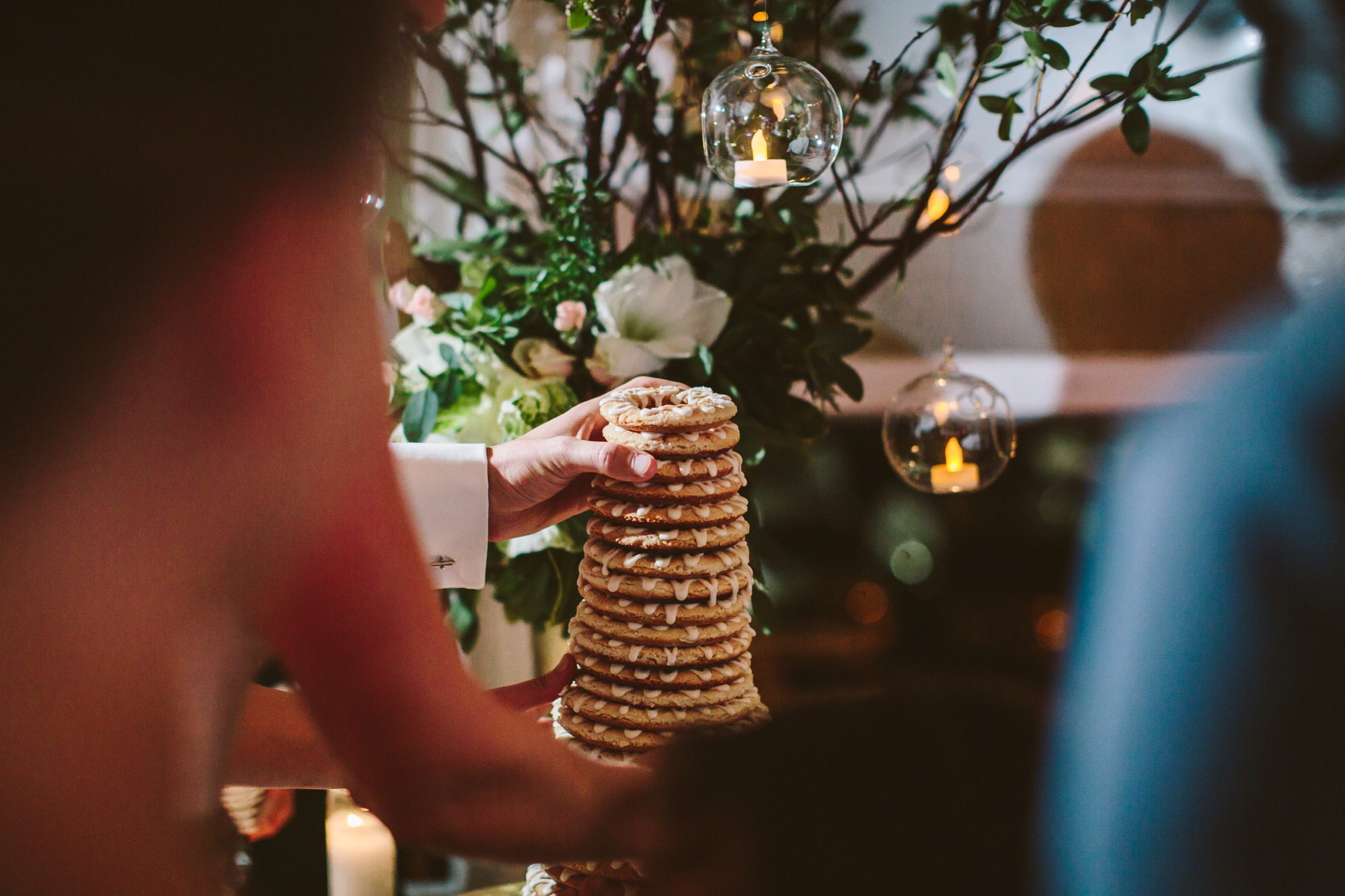
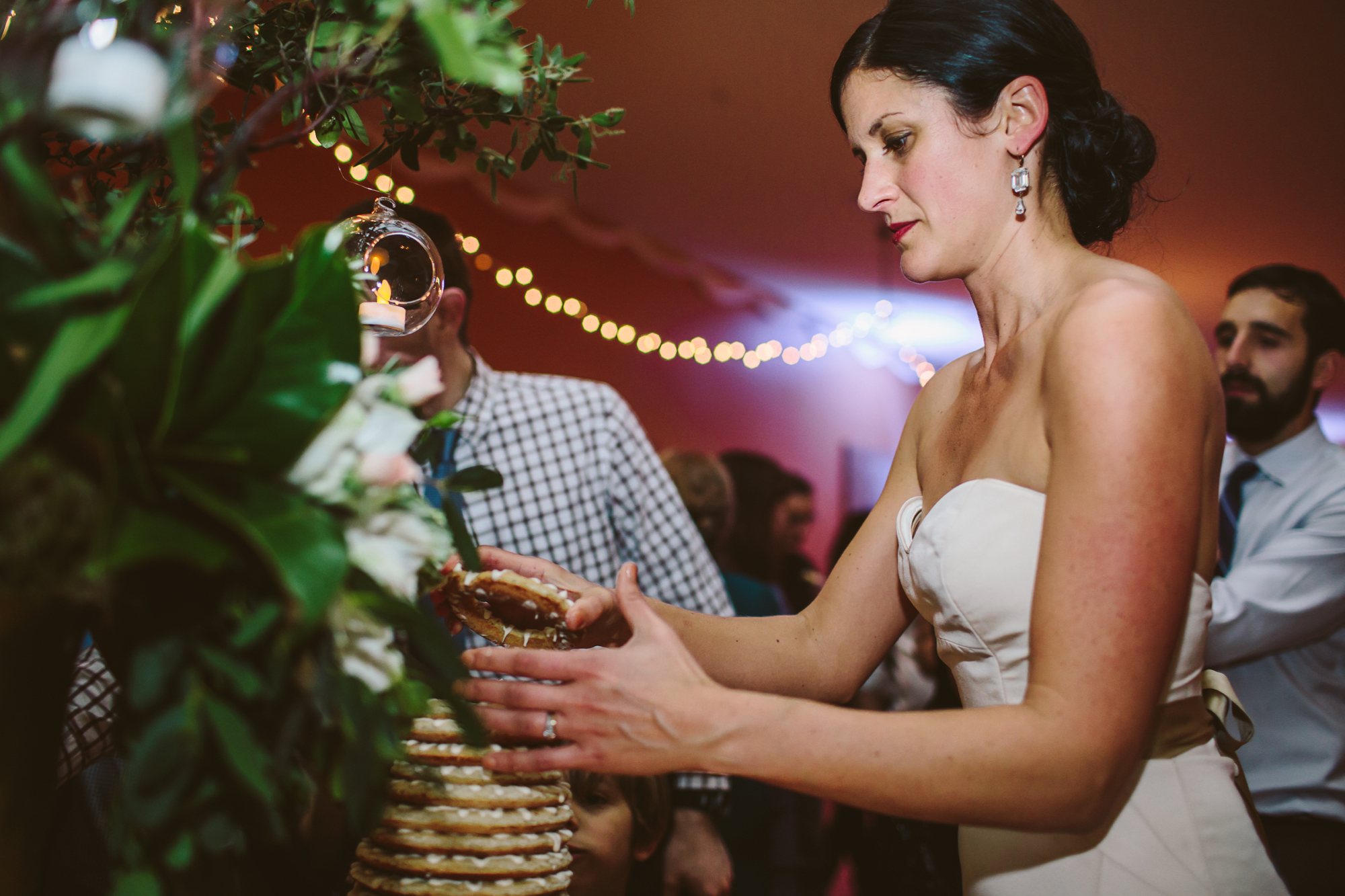

I originally intended to purchase a kransekage cake from a baker for the wedding, but being the crazy person that I am, I ended up making it. I'm not saying this to brag (okay, maybe I am just a little), but really - the cake is that easy that a bride can make it for her own wedding! I made my other friend's more classic American wedding cake and I would never put that pressure on myself as a bride. Also, I did have some delicious back-up truffles made by a local baker just in case. The great thing about this cake is that, in addition to being super simple and forgiving, you are supposed to make it a few days in advance to let the rings reach their optimal chewiness. Truly! Don't let the fact that you need special pans turn you away, as you can buy them on Amazon for twenty bucks. That being sad, I am absolutely willing to sell this cake to anyone who's interested in my making it for their wedding!

My wedding cake test-run.

Almond-cardamom cake rings fresh from the oven.
I've been meaning to post this recipe for some time, but now that it's been nearly a year since our wedding(!) and I plan on making it again for our anniversary/NYE, I thought it was the appropriate time. Below I have the recipe to make about one (set of) pan's worth as well as 3x that, which is what I used for the wedding that served about 80 adults (though it went fast!) The preparation method is same for both. The measurements are in metric weight and U.S. volume, which I know is strange, but that's what worked the best for me!
Krasnsekage A Ingredients*: Makes enough dough for one set of these pans (~25 servings)
410 grams almond flour or finely ground almond meal (125g/cup), Bob's Red Mill's normal bag is 450g almond flour
410 grams powdered sugar
Up to 40 grams gluten-free, rice, or all-purpose flour (about 9g/Tbs, I ended up adding 3 Tbs at first, then 4 more Tbs)
3 tsp freshly grated lemon zest
3 tsp ground cardamom
1/2 tsp salt
3 large egg whites (= 90g)
Extra flour and grapeseed oil or cooking oil spray for greasing the molds
1 set of kransekage ring molds (18 rings)
Krasnsekage B Ingredients*: Makes enough dough for 3x one set of these pans (~80 servings)
1,100 grams (1¼ lbs) almond flour, or finely ground almond meal (125g/cup), Bob’s Red Mill normal bag is 450g almond flour
1,100 grams (1¼lbs) powdered sugar
Up to 100 grams (about 3/4 cup) gluten-free, rice, or all-purpose flour (about 9g/Tbs, I ended up adding 1/4 cup at first, then 6 more tablespoons)
2 tablespoons plus 2 teaspoons freshly grated lemon zest
2 tablespoons plus 2 teaspoons ground cardamom
1-1/2 teaspoons salt
8 large egg whites
Extra flour and grapeseed oil or cooking oil spray for greasing the molds
1 set of kransekage ring molds (18 rings)
Preparation: Same for both versions, but you'll prepare and bake 3 batches for Kransekage B.
Preheat the oven to 400°F. Spray the ring molds with cooking oil spray or lightly brush them with grapeseed oil. Lightly dust them with flour. Set them onto cookie sheets.
In a large bowl or bowl of electric mixer, combine the ground almonds, icing sugar, one-half of the flour, lemon zest, cardamom, and salt. Mix on low speed using hand mixer or Cuisinart to combine. Add egg whites one at time and beating well after each addition.
The dough should be starting to come together and come away from the sides of the bowl. You can tell if the dough is moist and pliable enough by pinching some of it between your fingers. It should stick nicely together. If it is too moist, add more flour by tablespoon. You are aiming for the texture of soft ‘playdough’.
Scrape the dough onto your work surface and pat it into a large ball. Cut the ball into quarters and roll each chunk into a smaller ball. Work with one ball at a time and keep the rest covered with plastic wrap to prevent them from drying out.
Roll each ball into a long, even rope. I found it handy to use a ruler to keep the ropes uniform. For my 18-ring set of molds, 1/2 inch thick. Lay a piece of rope into one ring at a time, pinching off the excess length and smoothing the ends together to seamlessly join them. The dough is very forgiving, and it`s easy to re-roll a few rings if you don`t have enough dough to make the last ones.
Bake in the preheated oven, in batches, for 8-12 minutes, until the rings are a golden caramel color. The smaller ring pans tend to cook faster, so check on them at 8 minutes.
Leave the cakes to cool in the pans, then carefully remove them. You may have to insert a knife tip underneath the rings to help them pop out of the pans. For Kransekage B, cool the cakes before removing, then wash, dry, and re-grease the pans for the next batch. Store cakse at room temperature for a 1-3 days, preferably 48 hours to give the perfect amount of chewiness. I found that it was better to leave to open air than putting in plastic bags.
Icing Recipe: Make below x1 for Kransekage A and x3 for Kransekage B
1 small egg white
1.5 cups (225 gms or ¼lb) icing sugar
1 teaspoons fresh lemon juice
Icing Preparation: Whisk together the egg white(s) and icing sugar. Add enough lemon juice to make it a good drizzling consistency. Spoon the icing into a piping bag with a small round tip, a squeezable plastic piping bottle made for icing, or a heavy duty plastic bag and snip off a tiny bit of one corner to make a round hole.
To assemble the cake, lay out your rings in order of size. Start with the largest ring and attach it to your base or plate with a ring of icing. Pipe zig-zags of icing loosely over the top of the ring. I added an extra squeeze of icing all the way around the ring, as added insurance since this wedding cake was so tall. If you are making a regular height cake, you won`t need the extra ring of icing -the zig-zags will be enough to hold the rings together. Place the next smallest ring on top and repeat. Continue until you reach the smallest ring at the top.
<img src="https://images.squarespace-cdn.com/content/v1/53df581ae4b0461efc5879aa/1481141410783-4NQ94ALIT65IOCK998HM/image-asset.jpeg" alt="The cake worked!" />

The cake worked!
The Celery Sour cocktail
No, really - tastes like celery.

This drink is crazy, in a good way. You take all of these ingredients that are tasty on their own, but sound really weird together (when was the last time you mixed Fernet with elderflower liqueur?) and they combine into an entirely refreshing drink that, yes, tastes a bit like celery. This cocktail is why I bother with cocktail recipes. Enjoy!
1-1/4 ounces (5 parts) gin, preferably St.George Spirit's Terroir gin
1 ounce (4 parts) St.Germain or other elderflower liqueur/cordial, such as this homemade elderflower cordial
3/4 ounce (3 parts) fresh lemon juice
1/4 ounce (1 part) pastis, such as Ricard
1/4 ounce (1 part) Fernet Branca
2 dashes of Peychaud's bitters
Lemon peel (garnish)
Shake all ingredients apart from lemon peel and serve up in a pre-frosted coupe. Garnish with lemon peel.
fennel, bulgur, & chicken salad with blood orange
A bright future for leftovers.
One of the most satisfying things to do in the kitchen is to reinvent leftovers and salads are a great way to do this as they allow for the addition of all kinds of bits and pieces. This recipe calls for chicken breast and provides cooking instructions, but there's no reason you couldn't chop up some leftover roast chicken, now is there? Along the same vein - no grapefruit? No problem - try oranges or even apples! Out of bulgur, but have some quinoa? Sounds great! Really - the possibilities are endless, but I really do enjoy this combination of the sweetly herbal, crunchy fennel and the juicy, rich blood orange paired with chicken and bulgur. Fantastic for lunches or picnics. Serves 4 as a main.

1 cup dry bulgur
Two 6-ounce boneless chicken breasts (preferably skinless)
2 tablespoons grapeseed oil, divided
1/8 teaspoon sea salt, divided
3 medium blood oranges
Juice from 1 lemon
1 large fennel bulb, with fronds (try wild fennel stalks and fronds!)
1/4 cup diced fresh green onion
Salad greens (optional)
Preheat the oven to 500 degrees F.
In a saucepan, combine bulgur with 1 cup water and bring to a boil. Cover, reduce heat, and simmer for 10-12 minutes, or until tender. Set aside to cool.
Meanwhile, coat the chicken breasts with 1/2 tablespoon of grapeseed oil and sprinkle with about half of the salt. Lay the chicken on a baking sheet and bake on the top oven rack for 15 minutes or until cooked through - flip the chicken halfway through cooking time. Allow to cool and then slice into 1/4-inch thick strips.
Cut oranges in half. Squeeze the juice from one of the halves into a small bowl or jar. Add the remaining grapeseed oil, salt, tablespoon of olive oil, and lemon juice to the blood orange juice. Whisk or cover jar and shake until thoroughly combined.
With a knife, remove the peel and outside pith of the remaining 5 orange halves. Slice into wedges. It's helpful to know how to segment citrus like a boss.
Remove the fronds from the fennel bulb and thinly slice the bulb. Chop several of the fronds, enough to fill 1/2 cup.
Toss bulgur with dressing, chicken, orange wedges, fennel bulb, fennel fronds, and green onion. Serve at room temperature or cold atop salad greens (if desired).
Preheat the oven to 500 degrees F.
In a saucepan, combine bulgur with 1 cup water and bring to a boil. Cover, reduce heat, and simmer for 10-12 minutes, or until tender. Set aside to cool.
Meanwhile, coat the chicken breasts with 1/2 tablespoon of grapeseed oil and sprinkle with about half of the salt. Lay the chicken on a baking sheet and bake on the top oven rack for 15 minutes or until cooked through - flip the chicken halfway through cooking time. Allow to cool and then slice into 1/4-inch thick strips.
Cut oranges in half. Squeeze the juice from one of the halves into a small bowl or jar. Add the remaining grapeseed oil, salt, tablespoon of olive oil, and lemon juice to the blood orange juice. Whisk or cover jar and shake until thoroughly combined.
With a knife, remove the peel and outside pith of the remaining 5 orange halves. Slice into wedges. It's helpful to know how to segment citrus like a boss.
Remove the fronds from the fennel bulb and thinly slice the bulb. Chop several of the fronds, enough to fill 1/2 cup.
Toss bulgur with dressing, chicken, orange wedges, fennel bulb, fennel fronds, and green onion. Serve at room temperature or cold atop salad greens (if desired).
Ashes to Ashes cocktail
A delicious way to ease into a meal that is lightly boozy without being boring or too sweet.

My usual go-to cocktails fall in the "highly alcoholic" arena because that's typically what I'm looking for, but sometimes you want to start out a little mellower. Unfortunately, it can be hard to find a drink that is lower in alcohol without being sweet or tasting watered down. This combination of fernet, rosemary honey, and lemon does a great job of whetting the palate without making you feel like your missing out.
I came across this combination at a.kitchen + bar in Philly where my friend I used to work with at the Nordic Food Lab is now cheffing. The food and a.kitchen is delicious, but a little intense, so starting with this light herbal aperitif was definitely the way to go (before drinking wine, of course). We requested the recipe and have had a fun time recreating the drink at home using foraged rosemary that is beginning to flower, making for an even more appealing garnish.
1.5 oz Fernet Branca
0.75 oz rosemary honey syrup (see below)
0.5 oz lemon juice
0.25 oz ginger syrup
Sparkling water
Fresh rosemary sprigs for garnish
Shake all ingredients apart from sparkling water and rosemary garnish, double strain, then top with sparkling water to fill glass (adjust water according to taste). Garnish with rosemary.
To make honey-rosemary syrup (you might as well make a batch of it for future drinks!):
Simmer 2 parts honey to 1 part water with 1 rosemary spring for about 10 minutes. Remove from heat, cool, then remove rosemary.
Fresh Crab with Wood Sorrel-Cilantro Sauce
Ocean strawberries meet wild wood sorrel.
Crab season is one of my favorite seasons of the year. I love the fact that we still rely on fishermen and women to brave the seas in order to bring us these delicious crustaceans. Growing up in Humboldt County, my family lived near a crab stand that purported the clever phrase of "ocean strawberries" on their sign and I like to think of them as a cross between this elegant description and giant bugs.
In our house crab alone was special enough and accompaniments didn't go beyond melted butter and crusty bread. Although I still agree that crab is special enough, I wanted to take advantage of the wild wood sorrel prevalent in my neighborhood by making a vibrant and spicy dipping sauce of wood sorrel, cilantro, serrano, and sesame.
“Many plants, including wood sorrel, contain oxalic acid, which can be toxic in large quantities. Remember to enjoy in moderation.”

Wood sorrel looks like clover, but with yellow flowers on long stems. These are the somewhat fleshy flower stems you may have chewed on as a child walking around town (at least I did) to release their sour juices. The juice or ground leaves can be used as a unique way to provide a lemony kick to sauces or as a bright garnish - a little goes a very long way. Wood sorrel is high in Vitamin C and some use the plant medicinally for liver and digestive issues, but these latter benefits are not confirmed by research. The reason why wood sorrel is so lemony is due to its oxalic acid content, which can be toxic if eaten in large quantities and those with kidney or intestinal problems and pregnant women should avoid it. However, other plants contain oxalic acid as well so the general rule of thumb it to eat wood sorrel in moderation, meaning using some in sauce or as a part of a salad or garnish every once in a while is fine, and consume in combination with a balanced diet. There are also no dangerous look alikes for wood sorrel, making it a great foraged food for newbies! The below recipe serves 4.
2-4 fresh crabs (2 for half a crab each, 4 for heavy crab eaters)
1/2 cup wood sorrel leaves
2 serrano peppers, chopped with seeds removed
1 cup cilantro, chopped
Juice from 1/2 lemon
1 tablespoon ponzu (can substitute 1 teaspoon soy sauce + 2 teaspoons water if needed)
1 teaspoon yellow miso
1-2 tablespoons toasted sesame oil
Cooking and cleaning the crab: Go here for more information and step-by-step photos.
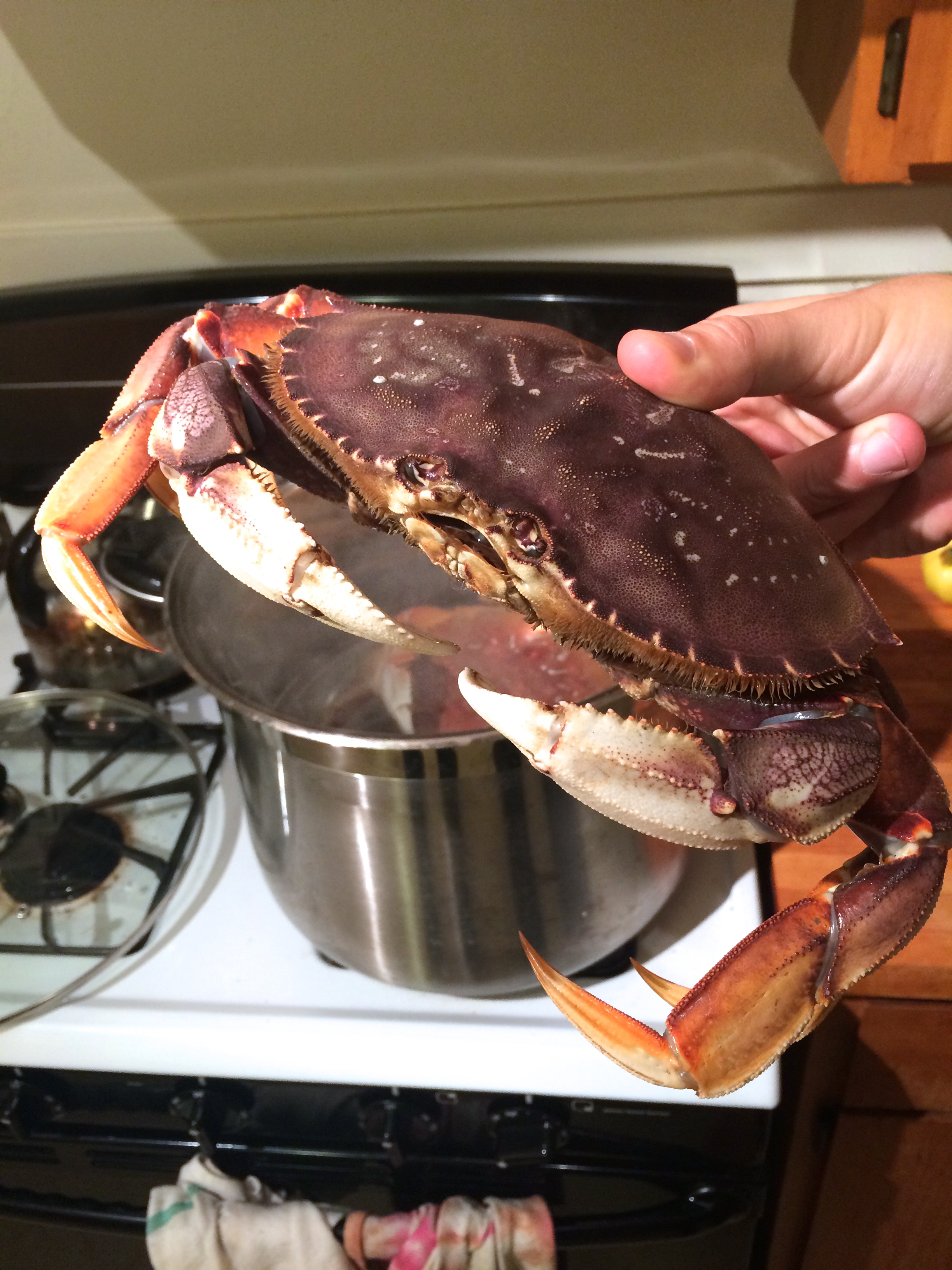
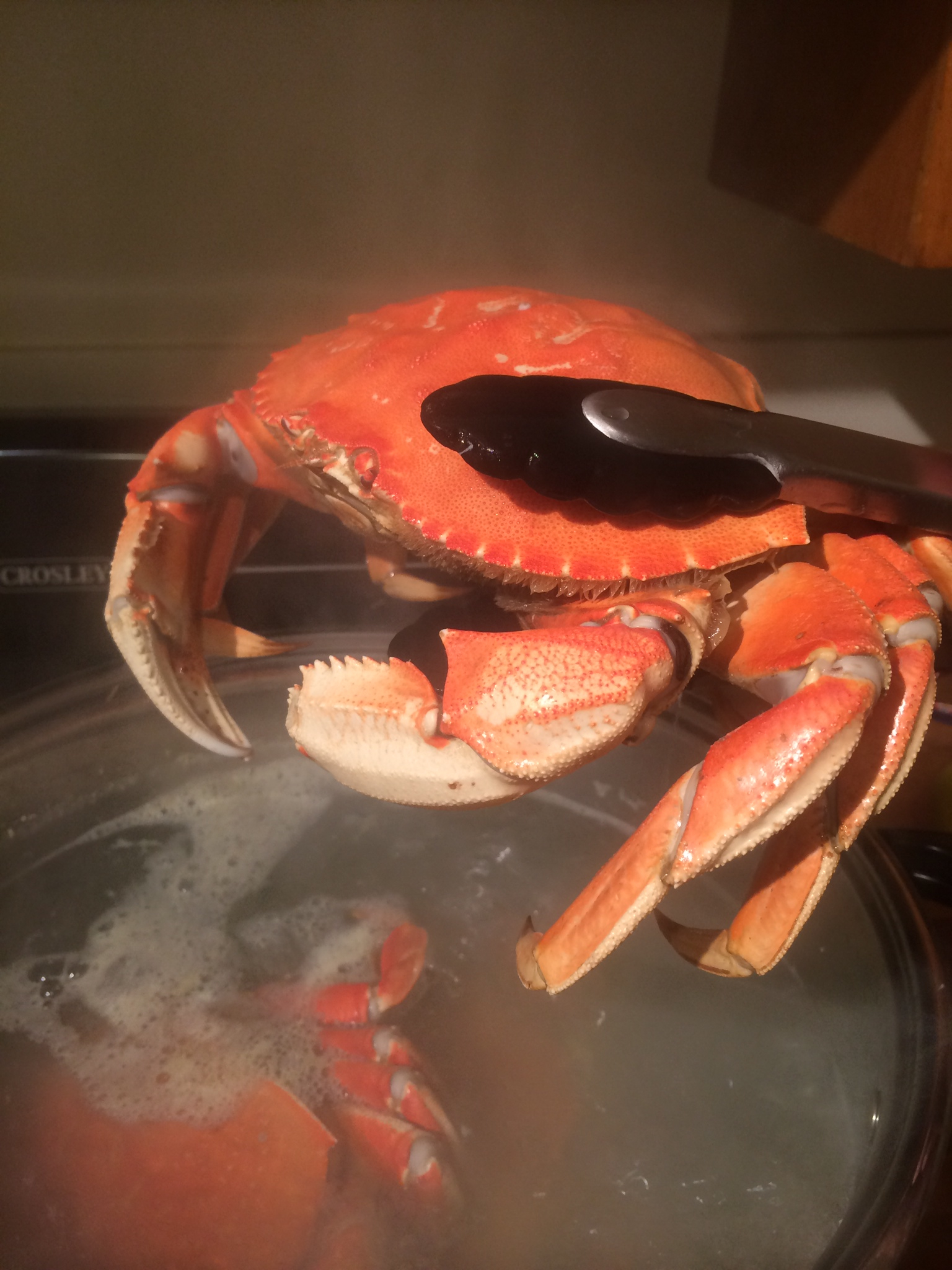
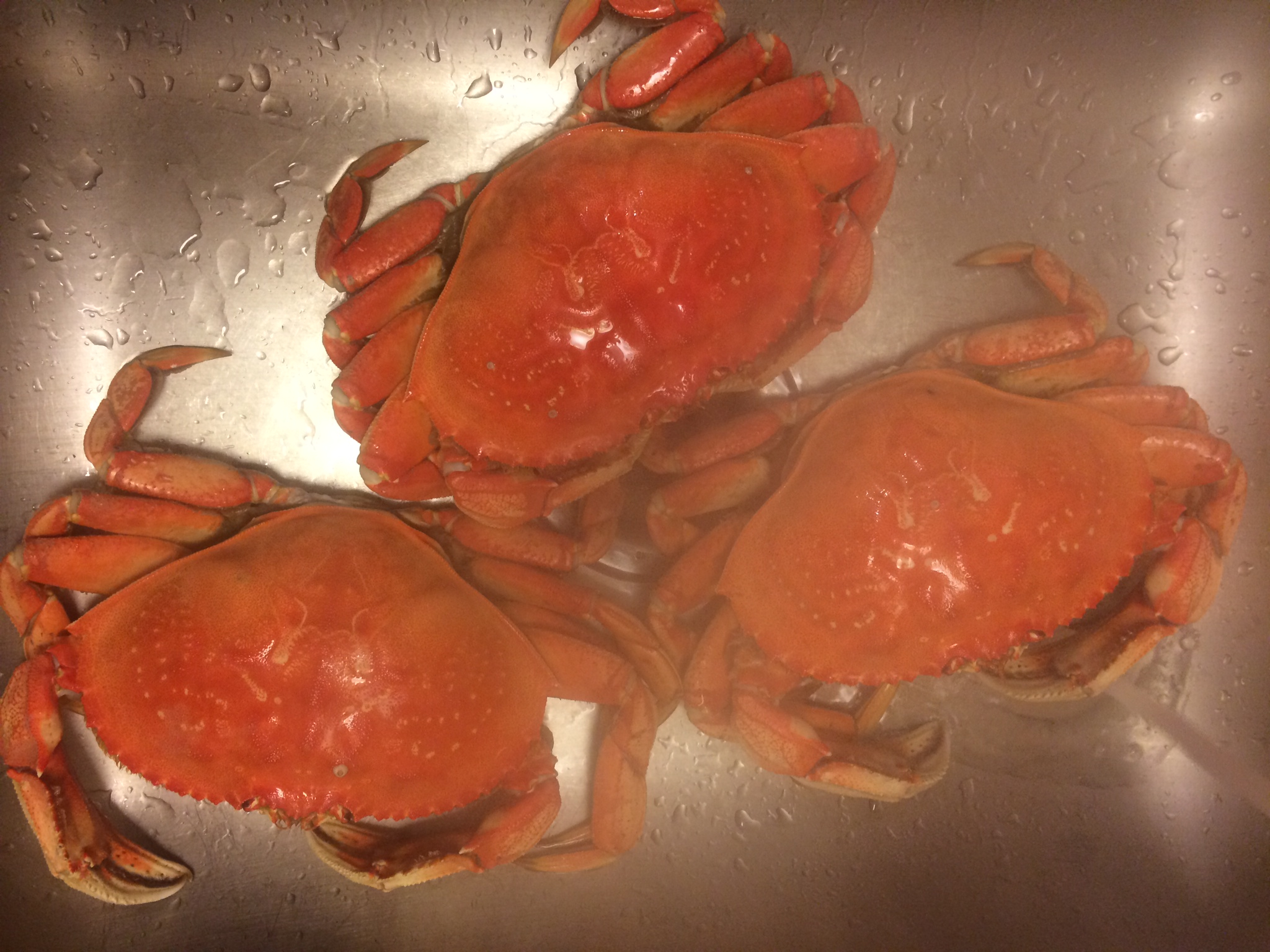
Get a large pot of water to a rolling boil. There should be enough water to cover the crabs. Throw your crabs in and cook them for ~7-8 minutes per pound. That's 7-8 minutes for the average weight of the crabs, not total weight. So, if I have 2 crabs that weigh 1.5 pounds and 2 pounds respectively, I should cook them for about 12-14 minutes. Round down when possible, as you can always cook the crab more if needed, but crab cooking is pretty forgivable. The crabs will change from a purplish color to a bright orange-red.
Remove crabs and rinse under cool water until cool enough to handle.
“Protip: All crabs available to eat are male, as the female are thrown back in to encourage population growth. ”
Turn the crab upside down. Stick your finger underneath the "apron" (little tail looking thing) and pull it off. Remove the carapace (large back shell) by putting finger in hole where apron was and ripping the back shell from the legs. It's actually pretty easy and fun.
Rinse off or save the guts (yellow gushy stuff) found in the carapace. The guts can be eaten on rice, in a stew, or on their own if desired.
Remove the gills (spongy soft jagged things) from either side of the body as well as the mandible (sharp mouthparts in the front).
Give the body a final rinse - remove the greenish-brown and yellow goop - and break the body in half if desired. Serve at room temperature or cold with wood sorrel sauce (below).
To make the wood sorrel sauce: Simply blend all ingredients except sesame oil in a food processor or immersion blender. Drizzle in sesame oil until desired flavor and consistency is achieved.
Here's a quick video demonstrating how to clean a Dungeness Crab:
Dandelion Greens Pesto
Put some wild in your pesto spread.
Put some wild in your pesto spread. The added dandelion greens make a lighter, bitterer tasting version of a classic cheese-free pesto. Up the ratio of greens to other ingredients if you desire an even lighter, less rich pesto. Makes about 3/4 cup.
1/2 cup raw pine nuts
1 bunch fresh basil leaves, plucked and chopped
3-4 tablespoons olive oil
1/4 - 1/2 teaspoon salt
2-3 cups chopped dandelion greens
Juice from 1/2 lemon
Combine pine nuts with basil, 3 tablespoons of olive oil, and 1/4 teaspoon salt in a food processor.
Once blended, incorporate dandelion greens and more oil and salt as needed to create desired texture and flavor. Blend in juice from 1/2 lemon.
Pesto may be frozen for up to 1 year, refrigerated for up to 1 week, or used immediately.


